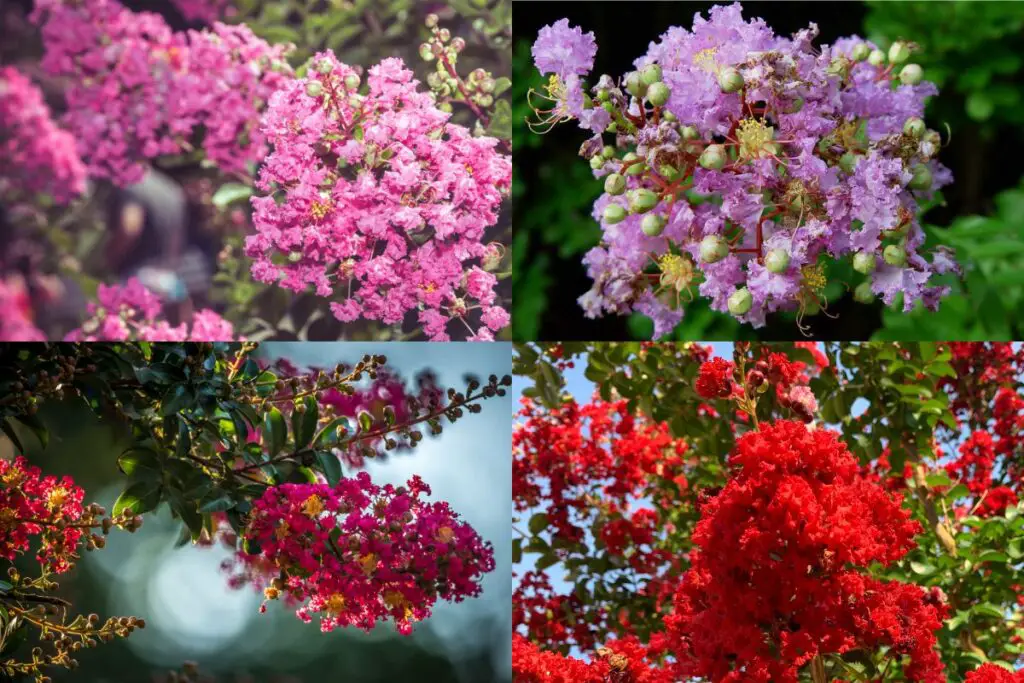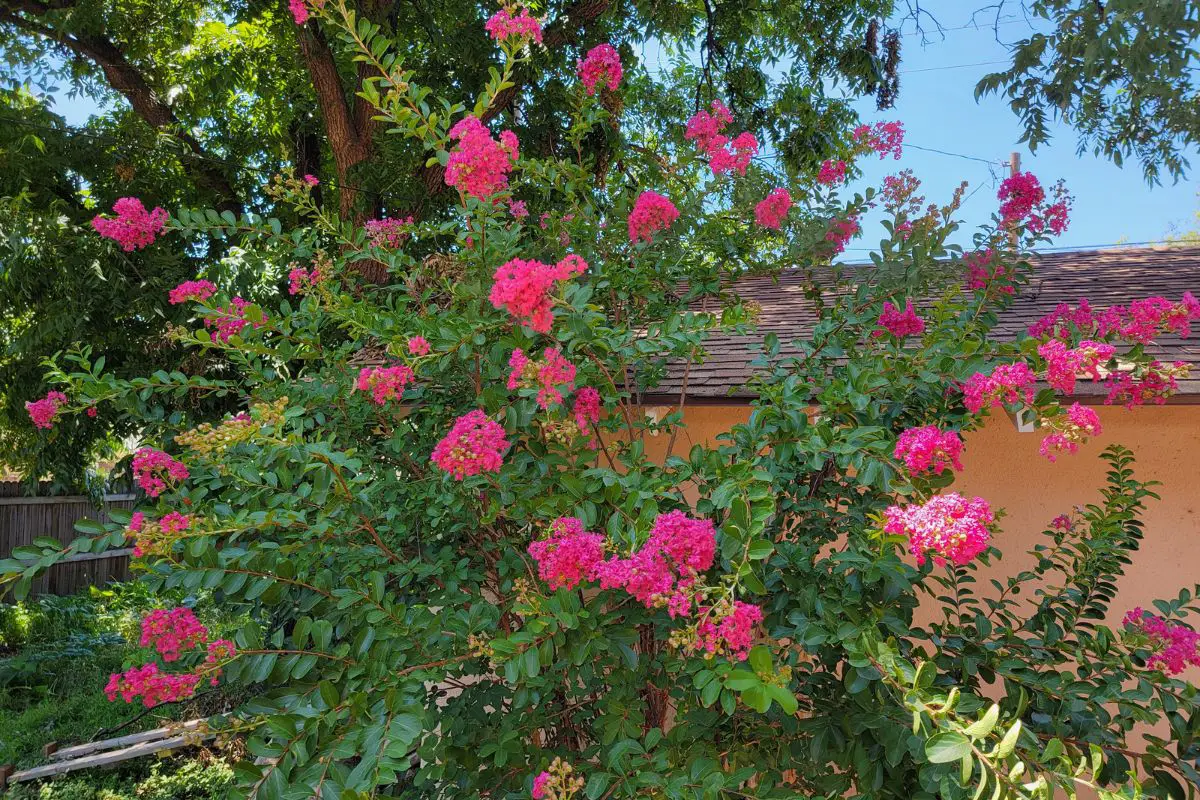I’ve been lucky enough to have crepe myrtles growing in my yard in the last two houses where I’ve lived. Over the years I’ve learned to care for them and enjoy their colorful blooms. One of my favorite things about them is the variety in crepe myrtle colors!
Crepe Myrtles are renowned for their vibrant and exquisite flowers. Cascading branches adorned with abundant clusters of blooms, featuring petals reminiscent of crepe paper, infuse the plant with color from spring through the entire summer season.
What are the best crepe myrtle colors? Let’s explore!
Table of Contents
What Colors Do Crepe Myrtles Come In?
Crepe myrtle’s bloom colors exhibit a diverse range of hues, including shades of pink, red, lavender, and purple. Additionally, they showcase an array of white blossoms, ranging from pristine white to white tinged with hints of pink or purple, and even white petals that create a striking contrast against burgundy foliage.
It’s easy to see where varieties like ‘Siren Red,’ ‘Pink Velour,’ and ‘Burgundy Cotton’ get their names. Given the myriad of species and cultivars available, you’re certain to discover one that aligns perfectly with your preferences in terms of size, shape, and color.
Which Color of Crepe Myrtle Is the Best?
Among my personal favorites for its captivating flower color is the ‘Tonto’ crepe myrtle. Its hue, resembling a deep pink bordering on red, is truly unique and challenging to describe. It could be likened to the deepest shades of fuchsia or magenta.
Remarkably resilient against diseases and deer, as well as drought-tolerant, this plant thrives in zones 7-10, encompassing the entirety of the South, a significant portion of the Southwest, a substantial segment of the East Coast, and the lower elevations of the West Coast.
The ‘Tonto’ crepe myrtle’s size is also an attractive feature. At maturity, it attains a height of 8-10 feet and a width of 6-10 feet, making it suitable for a wide array of landscapes.
Like other crepe myrtle species, ‘Tonto’ exhibits rapid growth and reaches its full height within a few years. Of course, tastes and purposes vary, so delve into the world of the crepe myrtles and find your favorite.

Fall Colors of Crepe Myrtles
While crepe myrtles dazzle with their eye-catching blossoms against glossy, dark green leaves during the summer, the spectacle continues into fall.
As the season transitions to fall, temperatures drop, and the blooms fade, the trees undergo a transformation with their foliage. Depending on the variety, you’ll be treated to fall foliage in shades such as burgundy-red, bronze-red, orange-red, and orange-yellow.
Showcasing the Most Beautiful Bark
Abundant and showy blooms that persist for months, coupled with stunning fall foliage, are accompanied by another captivating aspect: exfoliating bark that imparts interest even during the plant’s dormant phase.
Among the top contenders for visually appealing bark is the ‘Natchez’ crepe myrtle. Its gray bark naturally peels away, unveiling a captivating rust or cinnamon hue underneath.
Prior to selecting a ‘Natchez’ crepe myrtle for your landscape, it’s essential to understand its characteristics. This plant bears white blooms, so, if you’re seeking an explosion of red, pink, or purple hues, you may want to consider an alternative variety.
Furthermore, while some crepe myrtles classify as shrubs and others as trees, the ‘Natchez’ is unquestionably a tree, attaining heights of up to 30 feet.
Accelerated Growth: The Fastest Growing Crepe Myrtle
‘Basham’s Party Pink’ stands as the unequivocal champion among swiftly growing crepe myrtles. Generally, crepe myrtles exhibit rapid growth, advancing by 2 feet or more annually.
However, ‘Basham’s Party Pink’ can attain an astonishing growth rate of 8 feet per year and has even been documented growing 12 to 15 feet within a single year.
As its name implies, this variety boasts bold pink flowers. When planting these trees, provide ample space, as they can reach heights of 25 to 30 feet with a canopy spanning 20 feet in width.
Additional expeditious growers include ‘Red Rocket,’ ‘Tuscarora,’ and ‘Muskogee,’ each showcasing red, pink, and purple flowers, respectively. If you seek a smaller yet fast-growing option, ‘Red Rocket’ peaks at 10 to 15 feet.
Exploring the Deepest Hue: The Darkest Crepe Myrtle
Two noteworthy contenders in the quest for the deepest crepe myrtle color are ‘Dynamite’ and ‘Red Rocket.’ Originating from Southeast Asia, crepe myrtles initially exhibited flower colors encompassing white, pale lavender, and profound pink shades.
Coupled with glossy, dark green leaves that transition to autumnal yellows, oranges, or reds, these varieties have flourished in the United States for over two centuries. Nevertheless, recent decades have ushered in a profusion of captivating new cultivars.
In the 1990s, Dr. Carl Whitcomb made groundbreaking strides by employing chemical treatments to create mutations in crepe myrtles, resulting in numerous cultivars featuring deep red flowers.
Is There a Dark Purple Crepe Myrtle?
Crepe myrtles encompass an array of purple shades, ranging from delicate lavender to regal, dark purples. Should you seek a genuinely deep purple variety, consider the ‘Purple Velvet’ cultivar.
Standing as a dwarf option, the ‘Purple Velvet’ crepe myrtle attains a height of 4 to 5 feet. Its compact size renders it a versatile choice for various landscape spaces where larger plants might not fit.
Another exceptional alternative boasting rich, dark purple blooms, is the ‘Powhatan.’ While ‘Purple Velvet’ assumes a shrub-like form, the ‘Powhatan’ undoubtedly emerges as a tree, soaring to heights of up to 20 feet.
Which Crepe Myrtle Is Hot Pink?
A plethora of crepe myrtle varieties boast pink flowers, and the ‘Hot Pink’ cultivar lives up to its name with its vivid, stunning blooms. This compact variety reaches a height of 6 to 8 feet.
Another cultivar boasting resplendent hot pink flowers is the ‘Pink Velour.’ Both selections display remarkable resistance to powdery mildew and thrive in drought-prone conditions.
Unveiling the Factors Influencing Crepe Myrtle Color
When planting purple crepe myrtles, prioritize ample sunlight exposure. Varieties that receive inadequate sunlight may produce less brilliant flowers.
The pigment responsible for crepe myrtle color, anthocyanin, is activated by sunlight. The first moments after a flower bud opens are crucial for sunlight’s impact on coloration.
Consequently, if flowers open on overcast days or experience reduced sunlight, they may adopt lighter shades, potentially even turning white. Flowers that open later tend to regain their full coloration with appropriate light exposure.
However, it’s worth noting that not all crepe myrtle varieties react in the same manner. Dr. Carl Whitcomb’s ‘Siren Red’ cultivar, for instance, consistently unfolds with blood-red blooms, irrespective of light conditions.
Moreover, several other factors, including soil pH, moisture levels, temperature, and herbicide use, can also contribute to pigment intensity, albeit to a lesser extent.
Is There a Blue Crepe Myrtle?
While most crepe myrtles that suggest a blue hue lean more towards light, lavender-like shades, true blue crepe myrtles are a rarity.
Nonetheless, ongoing research endeavors are aiming to comprehend and influence flower coloration in these plants, potentially leading to the emergence of novel blue-hued varieties in the future.
Alongside blue, other colors not exhibited by the flowers of crepe myrtles include tones of yellow and orange.
Want to learn more about perennials? Check out: Perennials That Bloom All Summer!
In Conclusion
For those seeking shrubs or trees that offer a dazzling floral display, crepe myrtles undoubtedly deliver. Abundant panicles bedecked with exquisite, vibrant flowers spanning a spectrum of colors make these plants an awe-inspiring sight.
Enhanced by captivating foliage and exfoliating bark, they ensure year-round allure. With an ever-expanding array of crepe myrtle varieties, the possibilities are endless, guaranteeing you’ll discover at least one, if not several, that capture your heart.
What’s your favorite crepe myrtle color? Tell us about it in a comment!

